My daughter, Julia, and I have a long history of looking at and writing about art together. When she was four years old, I began a Master’s program in Art Education, and quickly involved her in my research into how children and families access museums. From having her take photographs of the art from her height (which revealed that most smaller, classical works in museums like the Kimbell are completely obscured by glares from a child’s vantage) to doing a deep dive into self-guided materials available for families, Julia helped me better understand a child’s perspective of these institutions and the possibilities they afford for family experiences. As she aged, her excitement for attending gallery openings and seeing art with me waned; but more recently, as she’s neared graduating from high school, she has shown a renewed interest in viewing (and even making) art together.
After I attended the press preview for the Modern Art Museum of Fort Worth’s I’ll Be Your Mirror: Art and the Digital Screen, curated by Alison Hearst, I immediately saw the value in revisiting the exhibition with Julia. The show brings together artworks created from 1969 to the present, which examine screen culture through a variety of mediums. Due to the five-decade time span, the pieces utilize a wide range of technology, from the obsolete 1985 Amiga computer to augmented reality, and nearly everything in between. My initial thought was that Julia’s perspective, as a 16-year-old who has grown up inundated by technology, might reveal something about the show that I, as someone who grew up at the cusp of the digital revolution, might not glean on my own.
We spent nearly two hours in the exhibition, and technology was, surprisingly, a topic that came up the least. Instead we talked about the passing of time, storytelling, the sexualization of the female body, toxic masculinity and violence, Whiteness, and perhaps most significantly, the collective consciousness and what it means to be original. Though technology is the unifying force behind the exhibition, just as its title proclaims, more so than anything, technology holds a mirror up to society.

Lynn Hershman Leeson, “Lorna,” 1979-1984, single-channel digital video in an interactive installation with living-room props, dimensions variable. Collection of the Carl & Marilynn Thoma Foundation.
At her high school, Julia is involved in theater tech, which, coupled with my interest in photographing interiors, landed us both in front of Lynn Hershman Leeson’s Lorna, an interactive video work set amongst a fabricated living room full of furniture and props. Created in 1983, the year I was born, the piece was the first interactive video work on a laserdisc, though it has now been migrated to DVD. Using a TV remote to access the work’s 36 chapters allows the audience to explore Lorna’s personal history in a choose your own adventure format. We marveled at the idea of the piece, but struggled to operate it in a fulfilling way. Similarly, we were unsure if we could sit on the furniture, so instead we awkwardly stood behind the living room set as we attempted to navigate the story. Ultimately, the installation left me wanting to take the DVD to peruse from the comfort of my own home, though this could be more of an indictment of society’s current way of ingesting media than of the artwork itself. After a few clicks through the piece, we were ready to move on.
In the same gallery (which also held Frederick Hammersley’s 1969 computer-generated drawings, Nam June Paik’s TV Buddha, and Andy Warhol’s Andy2), we spent most of our time standing in front of Tatsuo Miyajima’s Time in Blue No. 29. The 1996 piece is made up of 61 blue LED counters strewn across a black wooden panel, like stars dotting the night sky. Each is counting from one to nine at its own pace, in a continuous loop. We noted how the individual counters could be seen as singular moments passing by before our eyes. Over 14 feet tall, the piece reads like an ominous monolith, towering above the other works in the gallery. And just as ancient structures, like Stonehenge, demand a sense of awe and wonder, Julia and I found ourselves drawn to the piece, frozen in front of it, contemplating time, memory, life, and death. I have seen this and other works by Miyajima before, and I am still surprised by how captivating his simple pieces can be.
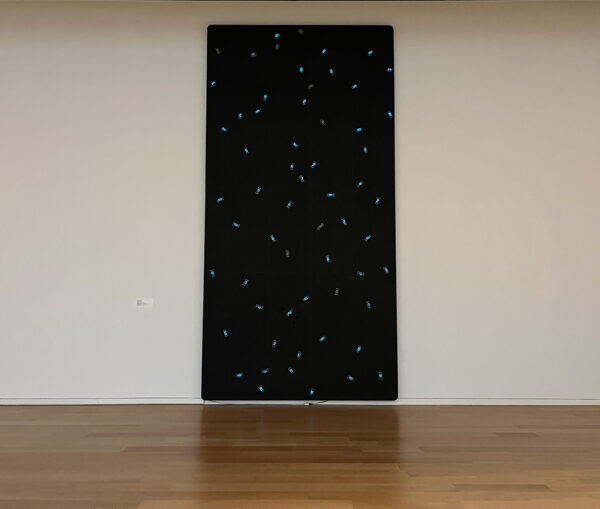
Tatsuo Miyajima, “Time in Blue No. 29,” 1996, sixty-one blue LED counters, IC electrical wire on black wooden panel, 175 1/2 x 89 x 3 7/8 inches. Collection of the Modern Art Museum of Fort Worth, Museum purchase.
While Time in Blue No. 29 resulted in some of the most poignant conversations we had, Julia’s favorite work was Kristin Lucas’ flARmingos. Though initially drawn to the blocky Minecraft-like IRL sculptures of pink flamingos, Julia was excited to interact with the augmented reality component of the piece. A wide, youthful grin came to her face as she held up the provided tablet and tapped the screen to generate an AR (augmented reality) flamingo; playful music added to her sense of joy. Rather than marveling at a singular flamingo, she continued to tap the screen, amassing more birds before our eyes, in what Julia first dubbed “a flamingo rave,” and then later “a flamingo revolt.”
Our time in the exhibition was punctuated by a planned lunch at the Modern Cafe, so we had to move on to make our appointment, but it was difficult to pull her away from the experience. As we walked away, she spoke to her flock with a soft smile, saying, “Goodbye my loves… don’t forget me, your mother, who will lead you to glorious victory against the Modern museum and the oppressive patriarchy you’re living in.”
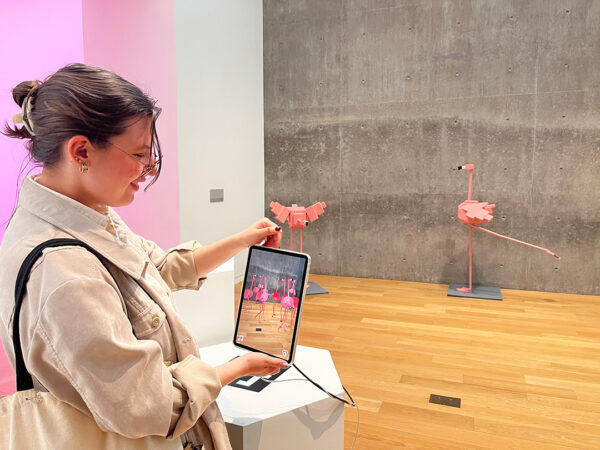
Kristin Lucas, “flARmingos,” 2017, AR, dimensions variable. Courtesy of Kristin Lucas. Support for this production was provided through an Engadget Alternate Realities Grant and a Pioneer Works Technology Residency.
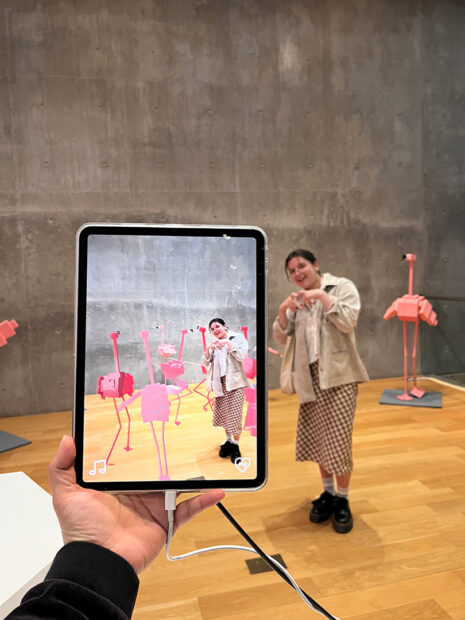
Kristin Lucas, “flARmingos,” 2017, AR, dimensions variable. Courtesy of Kristin Lucas. Support for this production was provided through an Engadget Alternate Realities Grant and a Pioneer Works Technology Residency.
In general, Julia was less interested in the newer technology on view because to her, it is ubiquitous. She compared flARmingos to games like Pokémon Go, which was entertaining when it first came out in 2016, but since then, the novelty of AR games and apps has worn off. In a museum setting, flARmingos was captivating because it was familiar enough for us to know how to engage with it, it featured cute creatures, and also had an element of surprise — museum visitors are often discouraged from touching the work.
I’ll Be Your Mirror does have interactive pieces throughout, including Lynn Hershman Leeson’s Lorna; Rafael Lozano-Hemmer’s Pulse Index, which photographs your fingerprint and displays it on a screen; and Huntrezz Janos’ Hologram Mythography and Tinsel Polycarbonate, which use a camera and screen to display a real-time video of visitors in the galleries, their faces distorted by colorful, mask-like filters. But, flARmingos was interactive in a way dissimilar to other piece. From an outside perspective, I suspect the draw for Julia was that it allowed her to create something, to feel an ownership over something, and in doing so, to move from the role of consumer to creator.
One of the last works we saw was Molly Soda’s Me Singing Stay by Rihanna, a video simultaneously playing 42 individual videos posted by young women of themselves singing Rihanna’s hit song about a relationship that has run its course. Julia and I had decidedly differing views of the dizzying cacophony of slightly offset voices. As a teen who grew up watching other people’s YouTube, Musical.ly, and Tik Tok videos, Julia viewed the piece through a heavy lens of cynicism. She saw both an overwhelming lack of originality, by the women who recorded themselves and the artist who brought the videos together; overall, a grid of people who were likely motivated by chasing viral status.
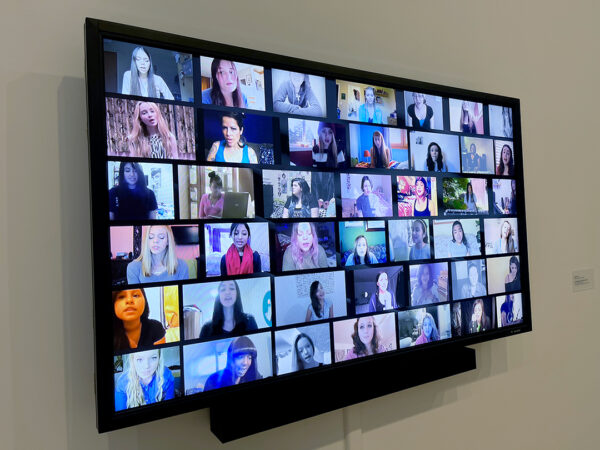
Molly Soda, “Me Singing Stay by Rihanna,” 2018, video, duration: 4 minutes, 30 seconds. Collection of the Carl & Marilynn Thoma Foundation.
Perhaps it is my age, or maybe my lack of time spent watching these kinds of videos, but I saw a collection of young women who were individually moved by and sincere about their own production of the song. As someone who could never fathom singing in front of others, let alone recording it and putting it out into the virtual world for anyone to hear or comment on, I saw vulnerability and connection. As evidence, I point out to Julia the facial expressions of many of the women, who seem to be truly feeling an emotional pain as they sing lyrics that practically beg a person to stay in a relationship with them. I thought back to my time as a teenager, when I often felt disconnected from the people around me, and saw that through this piece Soda unites people who may otherwise feel desperately alone. Her video made me think of the collective consciousness, and how even though our lives are our own, across the world there are people having incredibly similar thoughts and experiences.
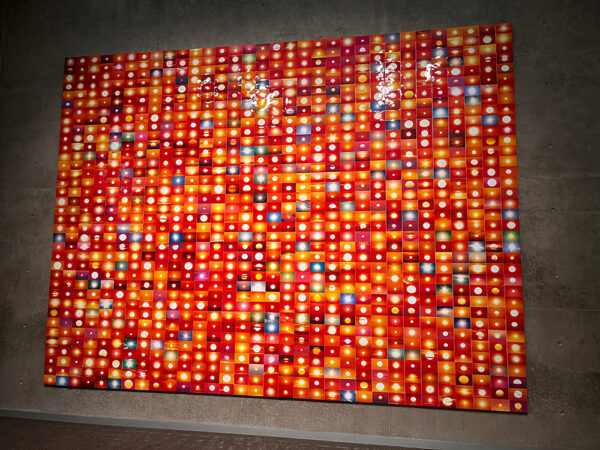
Penelope Umbrico, “48,586,054 Suns from Sunsets from Flickr (Partial) 11/05/20,” 2020, 1,152 4 x 6 inch C-prints, 144 x 192 inches. Courtesy of Penelope Umbrico.
Before we left the museum, we circled back around to the beginning of the exhibition to visit a piece we had walked by earlier — Penelope Umbrico’s 48,586,054 Suns from Sunsets from Flickr (Paritial). In a much larger grid than the 42 singers in Soda’s video, Umbrico collected and presented over 1,000 four-by-six-inch printed photographs of the sun, taken by various photographers and posted to Flickr. Though the piece is quite different in execution from Soda’s, it also speaks to the idea of shared experiences brought to light via social media platforms.
Julia was almost disgusted by the banality of the individual photographs. When we reflected back on the show, she told me, “The piece is boring, in general… the sun photos, although they could be backed by an actual emotion, a lot of that stuff is like, How many more followers can I get? How will this photo allow people to see me in a more positive light? It’s probably meant to be uploaded to social media as an aesthetic thing… in a way it’s like trends… and how everybody does the same thing, over and over again.”
I pushed back and explained that prior to the proliferation of social media, people were taking photographs of things we see everyday, like the sun, because it was important, meaningful, or beautiful to them. And sure, that type of photograph isn’t the most original or unique artistic production, but what once was a solitary moment of contemplation can now simultaneously be seen as a collective experience, and perhaps that makes it more powerful.
We talked about Flickr’s origins as a 2004 web-based program to host (and share) high-resolution photographs, but that the sharing involved was inherently different from what we think of as photo sharing today through platforms like Instagram. It’s hard to imagine a time without iPhones, but since the first one wasn’t released until 2007, the initial photos on Flickr were likely taken with digital cameras, or were even film photos that had been scanned. In this way, I see Umbrico’s piece as an ode to the collective consciousness. Yes, the individual photographs of the sun may not be something to write home about, but the artwork itself is about these shared experiences that cut across time and place.
Through our continued conversation, Julia and I were able to see each other’s perspectives, though we weren’t necessarily moved to change our own opinions of the works. Ultimately, our individual experiences with technology and our perspectives of the world shaped our viewing and understanding of pieces in the show. She approached many of the newer works with skepticism, I approached them with compassion; where she saw derivative pieces, I saw shared experience.
Perhaps this is always the case: what we bring to a work of art is equally as important as what the artist puts into it, or maybe more so, because we can’t escape our own views and experiences. The pieces that resonate with us are the ones that reflect our values, our questions, and our fears.
I’ll Be Your Mirror: Art and the Digital Screen is on view at the Modern Art Museum of Fort Worth through April 30, 2023.


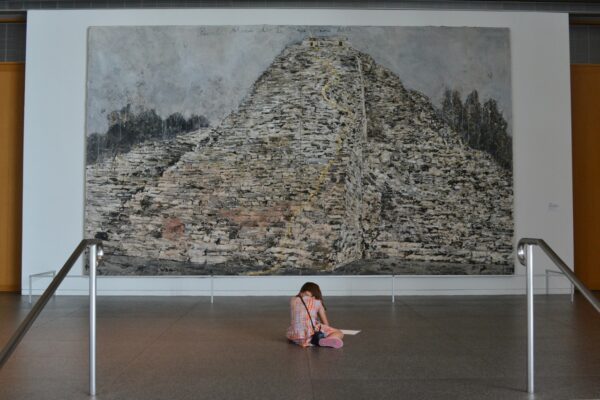

3 comments
This is such an interesting discussion, examination, review! Kudos to Jessica for bringing a deeper, more expansive, more integrated approach to talking and writing about art–and being led by the art and her life experience to do the same. The conventional art review is dead, and good riddance.
“Due to the five-decade time span, the pieces utilize a wide range of technology, from the obsolete 1985 Amiga computer to augmented reality”
The Amiga computer was introduced in 1985 but is far from obsolete. It is still being developed for and used in creating art today. As an example it featured prominently at Revision 2023 (https://2023.revision-party.net/#blog)
All the best-
32Bits
such a beautiful and illuminating way to reflect on the show, love the conversation between you two, thank you for the refreshing review